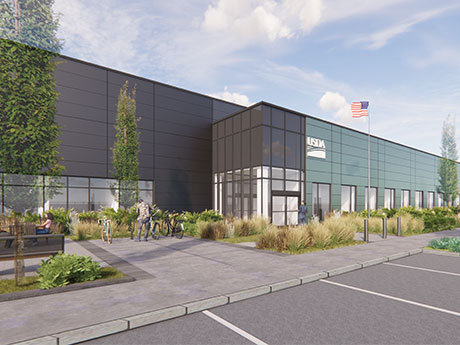By Mary Lamie, Bi-State Development
The industrial real estate market continues to show its strength in the St. Louis region as new investments by industrial developers hold steady.
Coming off a record year in 2022, with more than 7 million square feet of completions entering the market and 6.5 million square feet absorbed, the region’s new construction has leveled off a bit, with 1.1 million square feet of industrial space delivered so far in 2023 and 3.6 million square feet of space still under construction, according to the latest numbers from Colliers. Speculative construction rates remain high, with 65 percent of construction since 2019 being speculative builds.

This growth in industrial construction is being fueled by national and regional developers who believe St. Louis has the industrial activity levels needed to drive construction investments. Data included in the “St. Louis Regional Industrial Real Estate Market Indicators & Workforce Report,” released by the St. Louis Regional Freightway in May, shows the St.
Louis region now has 182 million square feet of space available.
According to the report, the region offers the largest amount of manufacturing space available on the market compared to other Midwestern cities, along with one of the lowest triple net lease rents, averaging $5.05 per square foot. As a result, St. Louis is an attractive option for manufacturing companies looking for existing places to grow and to expand their businesses.
A majority of the new industrial construction is located along a 70-mile transportation corridor that runs from Foristell, Mo., to Marine, Ill. Dubbed the “70s Corridor,” it encompasses Interstate 70 — which serves as a vital link between Missouri and Illinois and to both coasts — and portions of Interstates 170, 270 and 370. This major logistics corridor is home to a wealth of national manufacturers, suppliers and distributors, with room to develop even more. Nearly 90 percent of all industrial construction in the bi-state market over the last five years has been along this corridor, indicating its importance to both regional and national developers.
The 70s Corridor houses the region’s largest occupiers and employers, including Boeing, which received approval on Aug. 9 from the St. Louis Airport Commission to lease an additional 158 acres by the airport for a $1.8 billion expansion project that would create 500 jobs, adding to its existing regional workforce estimated at 16,000.
More than 70 percent of industrial users, with buildings exceeding 500,000 square feet, and approximately 75 percent of industrial occupiers, employing more than 1,000 local workers, can be found within a 10-minute drive of the corridor.
In 2022, the top six industrial leases, representing approximately 2.4 million square feet, were all signed with companies located along the 70s Corridor. Those leases include Gilmour, Reaction Auto Parts Inc., Spectrum Brands, Tempur Sealy, Trane and Tesla, which is new to the market. Tesla is leasing 700,000 square feet of space at Gateway TradePort, a planned industrial park in Pontoon Beach, Ill., which is one of the newest industrial parks in the 70s Corridor.
One of the biggest recent trends industrial real estate brokerage firms have been seeing along the corridor, especially in 2022, has been the shift from e-commerce and third-party logistics tenants to manufacturing tenants who need distribution space, and many of these companies are new to the region.
Ed Lampitt, vice chair of Cushman & Wakefield, says service deliveries continue to go up, meaning these users have to be closer to their customers. “We’ve seen a significant increase of new tenants and new users to St. Louis,” says Lampitt. “We used to quote that 17 percent of all deals were new to St. Louis, meaning they didn’t have a presence here. That’s doubled. It’s in the 30, 30-plus percent range.”
Not only does the St. Louis region have space needed for businesses to grow and expand, it has a trained workforce ready to meet the growing demand for industrial spaces in the market.
About 15 percent of the region’s workforce is within the production and transportation/material moving occupations. The top occupation within the 70-mile corridor is material moving workers — people hired by organizations like Amazon to stock, handle and ship goods in warehouses. Manufacturing is the second-largest industry along the corridor and accounts for more than 11 percent of total employment for the 70-mile stretch.
On I-70 alone, the St. Louis region handles more than 36,000 freight trucks daily — many of which serve the industrial facilities located along the corridor — and there is nearly $1 billion of infrastructure improvements underway or planned along the corridor to keep up with the needs of the freight and logistics industry.
The “St. Louis Regional Industrial Real Estate Market Indicators & Workforce Report” also found manufacturing workers throughout the region are some of the most productive. They produce an average of $687,000 in output annually per worker, versus the national average of $600,000, showing that manufacturing employees in the St. Louis region are nearly 15 percent more productive than the national average.
Within those industrial-focused occupations, the St. Louis bi-state area has more workers than the metropolitan areas of Kansas City, Louisville and Memphis, and that allows the region to compete for the national companies looking for both available industrial spaces and an available industrial workforce.
“The thriving industrial market is a valuable asset to the bi-state St. Louis region, drawing national investors with its robust industrial-occupier activity, providing ample distribution and manufacturing space to attract expanding companies, and boasting a skilled labor supply to meet the growing demand for modern bulk and manufacturing needs,” says Allison Gray-Gunsten, vice president of Steadfast City Economic & Community Partners, which prepared the report for the St. Louis Regional Freightway.
More information about industrial construction and space available can be found in the “St. Louis Regional Real Estate Market Indicators & Workforce Report,” which can be viewed in its entirety at www.thefreightway.com/resources.
Mary Lamie is vice president of multimodal enterprises at Bi-State Development and head of the St. Louis Regional Freightway. This article originally appeared in the September 2023 issue of Heartland Real Estate Business magazine.


